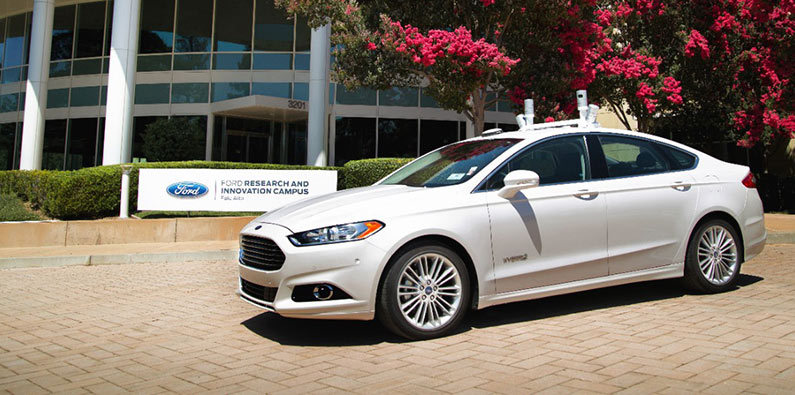
Ford has a long history of innovation and technology that began with the moving assembly line over a century ago. Today, Ford is still innovating, and demonstrating just how they’ve managed to stay on the cutting edge. In August, Ford announced its plans to offer a high-volume, fully autonomous vehicle ready for commercial operation in just five years.
By 2021, Ford will offer a vehicle to be used in ride-sharing and ride-hailing services, comprised entirely of driverless vehicles.
What began with automation of vehicle assembly has come full circle, and will now be fully-autonomous transportation.
Real-World Research and Application
To propel itself into the future, Ford is taking a revolutionary approach. While other manufacturers have focused on using partnerships and investments, Ford is doing the clear majority of its development in-house. They have recruited Rockstar engineers and designers from top schools like MIT, Stanford and the University of Michigan.
“We’re dedicated to putting on the road an autonomous vehicle that can improve safety and solve social and environmental challenges for millions of people.”
-Dr. Dieter Zetsche, Chairman of Daimler AG
Ford isn’t creating autonomous driving vehicles merely in a theoretical environment, either. Randy Visintainer, Ford’s director of autonomous vehicle development, believes that autonomous vehicles aren’t merely a sideline or something that Ford will have built; they are part of Ford’s core business going forward.
Putting the Pieces Together
Such an ambitious approach to futuristic driving technology requires using the cutting edge of available technology. As such, there are four areas to which Ford has devoted significant resources:
- LiDAR Sensors Investing in Velodyne, the leading authority in light detection and ranging (LiDar) sensors, was an important and necessary step. To be able to field a fleet of self-driving Ford vehicles, Ford needs to be able to mass produce automotive LiDAR sensors at a reasonable price point. The longstanding relationship Ford has had with Velodyne meant it was only natural that Ford would turn to that company for help with LiDAR.
- Artificial Intelligence The Israel-based company SAIPS was acquired by Ford to developing artificial intelligence for autonomous Ford vehicles. The company’s areas of expertise include image and video processing, signal processing and classification, as well as deep learning. This kind of expertise gives self-driving Ford vehicles the ability to understand and adapt to their surroundings.
- Visual Navigation Being able to process visual signals and interpret them correctly is an important part of autonomous Ford vehicles. To help with this aspect, Ford brought in Nirenberg Neuroscience LLC, a company that was founded by the neuroscientist who discovered exactly how the eye sends visual data to the human brain. Dr. Nirenberg has even developed a device that can restore sight for certain patients with retinal degenerative diseases. This kind of research and technology will allow self-driving Ford vehicles to process visual information.
- 3D Mapping Civil Maps, based in Berkeley, California, developed highly-efficient and innovative 3D mapping techniques. Their technology is highly scalable, and more efficient that competing processes. Partnering with Civil Maps will help Ford develop 3D maps of the environment around an autonomous vehicle.
- Civil Maps Ford has invested in Berkeley, California-based Civil Maps to further develop high-resolution 3D mapping capabilities. Civil Maps has pioneered an innovative 3D mapping technique that is scalable and more efficient than existing processes. This provides Ford another way to develop high-resolution 3D maps of autonomous vehicle environments.
Ford Media Autonomous Driving Video
Add in a significant expansion of its operations in Silicon Valley, and it’s pretty obvious Ford really does intend to make autonomous driving a reality as soon as possible. Currently, Ford is working with more than 40 startups in Silicon Valley, collaborating with companies and individuals that can help accelerate and refine the kinds of services and technologies necessary for the next great evolution in driving.



![[Facebook]](https://www.fordlincolncharlotte.com/blogs/594/wp-content/plugins/bookmarkify/facebook.png)
![[LinkedIn]](https://www.fordlincolncharlotte.com/blogs/594/wp-content/plugins/bookmarkify/linkedin.png)
![[Twitter]](https://www.fordlincolncharlotte.com/blogs/594/wp-content/plugins/bookmarkify/twitter.png)
![[Yahoo!]](https://www.fordlincolncharlotte.com/blogs/594/wp-content/plugins/bookmarkify/yahoo.png)
![[Email]](https://www.fordlincolncharlotte.com/blogs/594/wp-content/plugins/bookmarkify/email.png)

